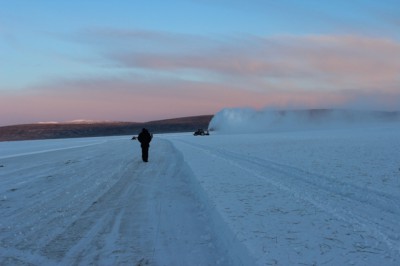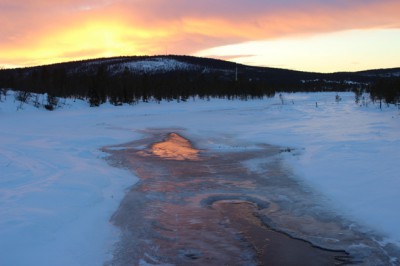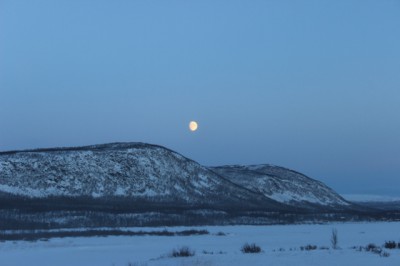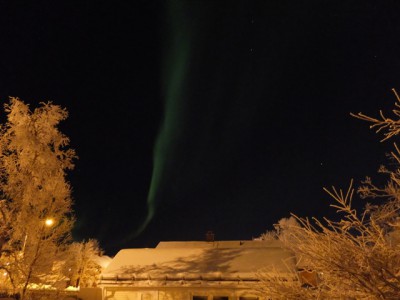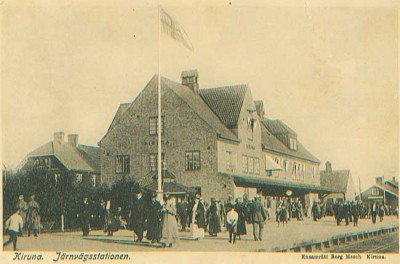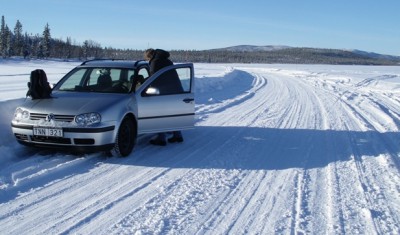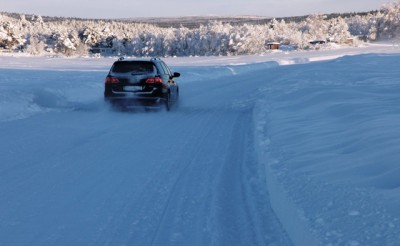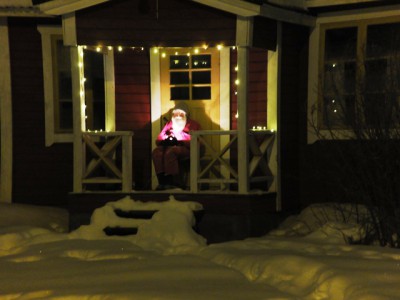Sometimes, sitting at home in the evenings, I notice how quiet it is. Kiruna seems hidden away, closed off. There are no cars passing by, no people, no sign of life. It feels a sort of Lake Wobegon of the north.
The snow can make you feel cut off, even though the roads are all kept open. Only some areas are kept clear, and these are usually where cars need to go, or where people need to walk to reach their houses. Where a path isn’t considered necessary a wall of white will quickly fill it and then you can’t see there was ever a path there.
Around our house we keep clear the area up to our front door, and a path down to our garage. The other parts of the garden all disappear. Everything is a soft white marshmallow of gentle ups and downs, swirls and hills.
In and around Kiruna we can only follow the paths that are open for us. As a runner, that’s roads and paths in town, or snow scooter tracks on the edge of town. As a car user there are only four routes out of town and two of them are dead ends, but they are all kept free of snow. Whenever we are out on a winter path or on a road we’re always on the look out for new ways through in the snow, new places to explore.
A few days ago on one of the regular roads out of town we saw a road we hadn’t seen before. How could we have not noticed it, leading so clearly into the forest? There was a large warning sign at the junction, which maybe we’d registered unconsciously before and assumed it said ‘no access’. But now we looked at it we saw it warned off walkers and dogs, but cars could use it ‘at their own risk’. Irresistible.
It didn’t appear to be going anywhere. We knew from the map that all there was here was low forest, and beyond that, a lake, which we had been on at another point further away. The ‘road’, we noticed, wasn’t a real road. Snow had been cleared from the ground in the forest and vehicles had driven over the thin layer left behind. At this time of year a road like that isn’t an easy option – you have to work hard to keep it free from snow, and given the length of this road, someone had worked very hard indeed.
We drove along it cautiously, noticing nothing unusual along the way. Then we reached the lake. The road continued down onto the ice, and a wide expanse of snow-free ice stretched far ahead in three directions. It felt like we’d crept through a secret door in the forest and stepped out into another world.
A heavy duty snow clearing tractor was out on the lake, a spray of snow shooting to the side. Near the tractor there was a man standing by a snow scooter. Nothing else to be seen but broad motorways of ice in all directions. We couldn’t work it out. There were no villages on the other side, no reason for ice roads, no reason for such a vast area to be so precisely and perfectly cleared of snow that the ice surface glistened in the low sun’s rays. What was all this for?
The great thing about going through a secret door in Kiruna is that you know it very likely leads to a memorable experience, not to a full stop. Anywhere else we might have just gone home, puzzled, but here the obvious thing to do was park the car, walk out onto the ice, and ask the man with the snow scooter what it was all about.
It was below minus 20 degrees out there and we felt it as we walked towards him. The man was dressed in boots and warm clothing, but it was hard not to notice his bare hands. Mine were smarting from the cold inside my gloves so I couldn’t take my eyes off his while Rolf was asking him what he was doing. As expected he was friendly and pleased to talk, and still the hands remained outside the pockets. Those hands, I thought, are used to cold temperatures.
So what were the ice motorways for? Well cars of course. Fast, new ones specifically. Companies come here to test drive their new cars (and, maybe, to show off a bit). The man we were talking to was employed every year to keep the lake area free of snow for the test drives, which usually took place in February.
It was quite a task, he explained. It’s a very large area of lake, and they can’t keep it clear of snow with just a snow scooter and a clearing tool. But to take a snow clearing tractor out there the ice needs to be at least half a metre thick to hold its weight so they can’t do that at the beginning of the season when the ice has only just formed. They can’t, either, just wait until it’s colder and hope the ice will be thick enough for a tractor, because if snow falls heavily it keeps the ice layer warm so the ice is less thick. So at the start of the season, in November, they have to clear relatively thin layers of snow from the ice with a snow scooter, and keep doing this until the ice is thick enough. Clearly it was thick enough now, because we were standing on the lake next to a tractor.
Before I even looked up at the driver of the tractor I’d guessed it would be a young woman. So typical in Kiruna.
A few minutes later the man on the snow scooter went back up the road, and the tractor moved further out on the lake.
I found myself thinking what it must feel like, being up there in the tractor’s driver seat, with a view out over the empty expanse of ice, shooting snow into the air. Later in life, I reckoned, she’d find it hard to think of a better job.
